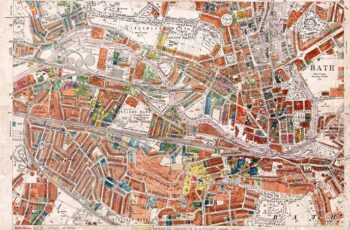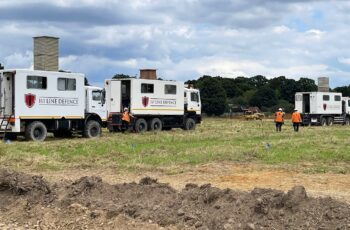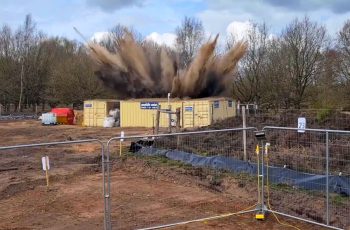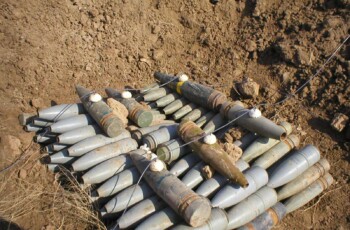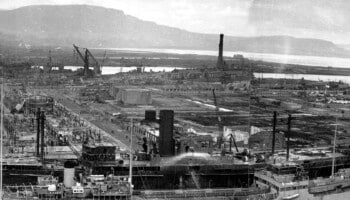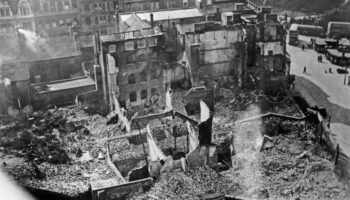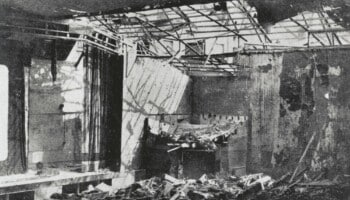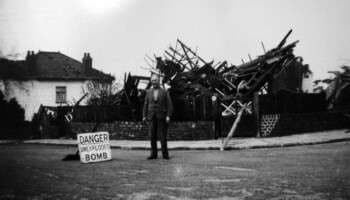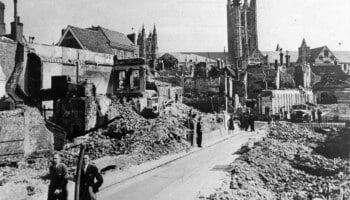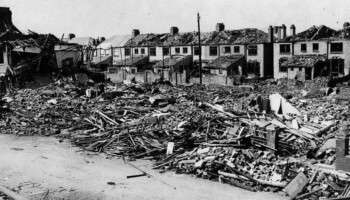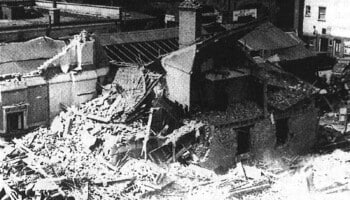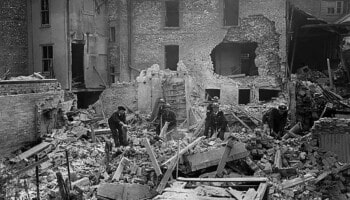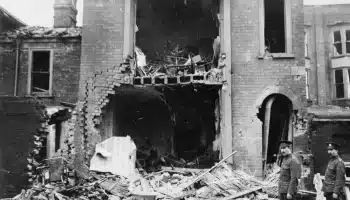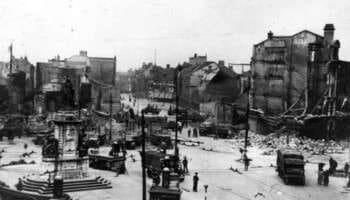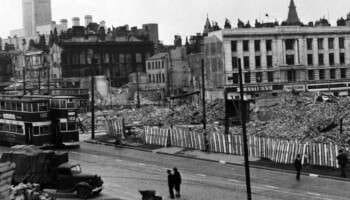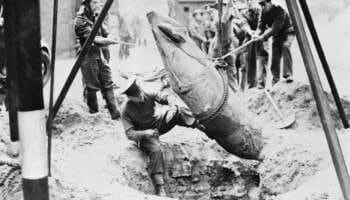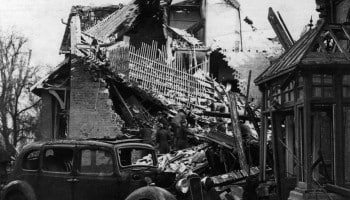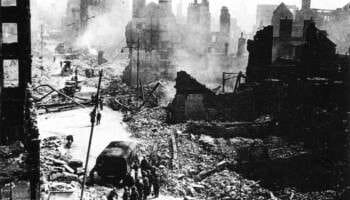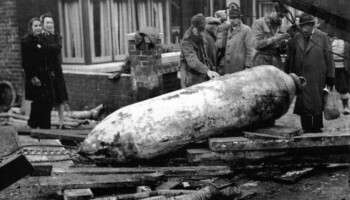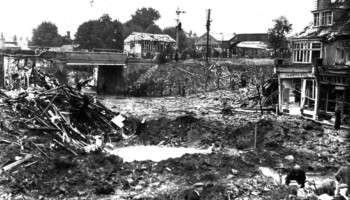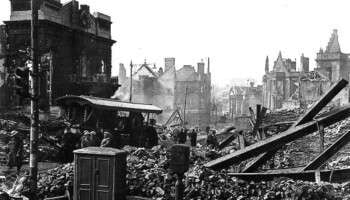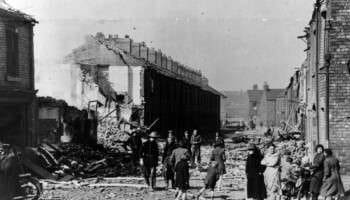Home » Resources » UXO City Guides »
UXO City Guide
Home Office Bombing Statistics for Clydebank
Record of German Ordnance dropped on the County Borough of Clydebank
High Explosive Bombs (All types)
348
Parachute Mines
27
Oil Bombs
0
Phosphorus Bombs
0
Fire Pots
0
Pilotless Aircraft (V-1)
0
Long-range Rocket Bombs (V-2)
0
Weapons Total
375
Area Acreage
2,196
Number of items per 1,000 acres
170.8
Why was Clydebank targeted and bombed in WWII?
Clydebank, located next to the city of Glasgow in Scotland, was subject to two major bombing raids and several smaller raids due to the presence of heavy industrial facilities in the town – including shipbuilding and munitions manufacture.
There were numerous key targets in Clydebank. The famous Singer Sewing Machine Factory, a 46 acre site at Killbowie, was switched to munitions production during the war, and suffered severe damage that resulted in the loss of over 390,000 square feet of the facility.
John Brown’s Shipyard (now Queens Quay) constructed a large number of warships such as the battleships HMS Duke of York and HMS Vanguard, the battlecruisers HMS Hood and HMS Repulse, and the aircraft carrier HMS Indefatigable. The Luftwaffe reportedly ‘levelled’ the shipyard and all of the tenements around it. Eye witnesses reported ‘blocks and blocks of rubble’1.
The Beardmore Engine Works (now the Golden Jubilee Hospital and Beardmore Hotel) reformed as the ‘Royal Ordnance Factory Dalmuir’ and manufactured medium-calibre guns – primarily anti-aircraft. The factory was targeted on at least two separate occasions.
At Dalnottar, eleven huge tanks were destroyed at the Admiralty oil storage depot, with others severely damaged. Millions of gallons of fuel were lost and the resulting fire burned for two weeks. When the area was finally cleared and inspected, ninety-six bomb craters were counted and recorded.
Home Office Bombing Statistics for Clydebank
Details recorded by the official Home Office bombing statistics, indicates the quantity and type of bombs that fell on the Parliamentary Borough of Clydebank during WWII (excluding incendiary bombs).
A total of 375 bombs fell on Clydebank, equating to an average of 170.8 items of ordnance recorded per 1,000 acres.
However, this does not account for any bombs that fell unrecorded during these raids. These unidentifiable items, falling unnoticed are what pose a potential risk to construction today.
Major bombing raids in Clydebank
The largest raids on Clydebank, referred to as the ‘Clydebank Blitz’, occurred on the nights of the 13th and 14th March 1941. The town suffered the worst destruction and civilian loss of life in Scotland during WWII. Over these two nights, Clydebank suffered 528 killed and 617 seriously injured, with a further 647 killed in neighbouring Glasgow2.
On the 13th March, 236 aircraft attacked the town, reportedly dropping 272 tons of high explosive bombs and 1,650 incendiary canisters. The following night, 203 aircraft dropped 231 tons of high explosive bombs and 782 incendiary canisters. These raids completely destroyed an estimated 4,000 houses and out of the 12,000 houses established in the town – only 7 were left undamaged3.
According to German sources, a total of 503 metric tons of high explosive bombs and 2,412 containers of incendiaries were dropped over the two raids.
Some of the other major attacks on the town occurred on these dates:
- 7th April 1941
- 5th and 6th May 1941
Below is an example of Clydebank bomb mapping, showing the locations of bomb strikes on Jellicoe Street and its surrounding areas during the 13th/14th March raids (obtained from the National Records of Scotland). Individual H.E. bombs during the raid were recorded by number to better track incidents across the town.
Can UXO still pose a risk to construction projects in Clydebank?
The primary potential risk from UXO in Clydebank is from items of German air-delivered ordnance which failed to function as designed. Approximately 10% of munitions deployed during WWII failed to detonate, and whilst efforts were made during, and after the war to locate and make UXBs safe, not all items were discovered. This is evidenced by the regular, on-going discoveries of UXO during construction-related intrusive ground works across the UK – not just in Clydebank.
Occasionally items of British explosive ordnance are also encountered in and around Clydebank – often associated with WWII defensive measures or Home Guard operations. However, there were few military related facilities in or around the city.
I am about to start a project in Clydebank, what should I do?
Developers and ground workers should consider this potential before intrusive works are planned, through either a Preliminary UXO Risk Assessment or Detailed UXO Risk Assessment. This is the first stage in our UXO risk mitigation strategy and should be undertaken as early in a project lifecycle as possible in accordance with CIRIA C681 guidelines
It is important that where a viable risk is identified, it is effectively and appropriately mitigated to reduce the risk to as low as reasonably practicable (ALARP). However, it is equally important that UXO risk mitigation measures are not implemented when they are not needed.
While there is certainly potential to encounter UXO during construction projects in Clydebank, it does not mean that UXO will pose a risk to all projects. Just because a site is located in Clydebank does not mean there is automatically a ‘high’ risk of encountering UXO. It really does depend on the specific location of the site being developed.
A well-researched UXO Risk Assessment will take into account location specific factors – was the actual site footprint affected by bombing, what damage was sustained, what was the site used for, how much would it have been accessed, what were the ground conditions present etc.
It should also consider what has happened post-war – how much development has occurred, to what depths have excavations taken place and so on. This will allow an assessment of the likelihood that UXO could have fallen on site, gone unnoticed and potentially still remain in situ.
Sources
1https://donmooreswartales.com/2011/02/25/jean-cole/
2MacPhail, I. M. M., The Clydebank Blitz, Cordfall, 1974
3https://glasgowpunter.blogspot.com/2017/03/bombs-over-glasgow-on-night-of.html
Recent UXO discoveries in Clydebank
Since the war, many items of UXO have been discovered across multiple cities within the UK, with Clydebank no exception. See the news articles below about UXO incidents and discoveries from national and local press in Clydebank.
1st Line Defence keep up-to-date with relevant and noteworthy UXO-related news stories reported across the UK, and you can browse through these articles using the buttons below.
Get UXO risk mitigation services from a partner you can trust
UXO City Guides
Got a project in Clydebank? Not sure if there is a UXO risk? Need advice but not sure where to start?
If you need general advice about UXO risk mitigation in Clydebank, contact us and we will be happy to help.
Contact Us
* indicates required fields
